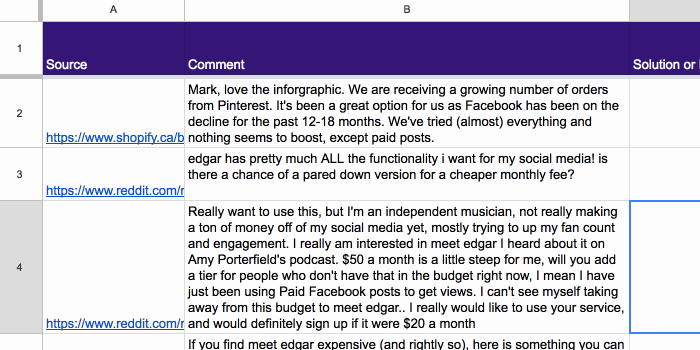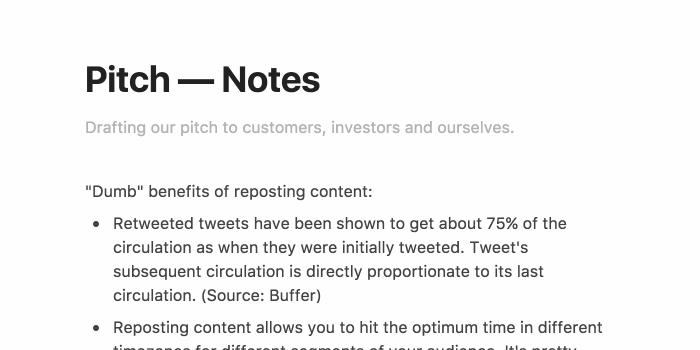Your Cart is Empty


Don’t find customers for your product. Find products for your customers. — Seth Godin
There’s a scene in Objectified in which a team of industrial designers is shown designing garden shears. Two or three New York MFA-types stand around a conference table discussing a prototype: where on the hand the shears will create friction, whether the grip is comfortable enough, whether the angle of the shears is correct and so on. That the delicate hands of an industrial designer are different from the callused hands of the average landscaper doesn’t seem to occur to them. Between them, they form a consensus and a new prototype is drawn up.
This is often about as thorough as design research gets. It’s no surprise then that most people end up skipping the research phase entirely. “Vision” is channeled, as is the maxim, “we only make products for ourselves.” This is one of the reasons why so many products fail to resonate. They’re created with a hypothetical customer or with no customer at all.
Designers, developers and product managers are often shielded by their clients from the realities of the market. In fact, it’s possible to have a fairly successful career without having to experience any real market pressure at all. As a result, many end up engaging in product development for its own sake. If you’re reading this, you’re likely one of those people. I was too.
It took quitting my job, founding my own company, and getting knocked around a bunch to finally find myself in alignment with the demands of real people. I’m still working on it. While my products pay the rent, I draw a salary that is less than the average Creative Director. But I also work less. And that’s great.
In this short essay, I’ll be walking you through a method, pioneered by Amy Hoy and Alex Hillman, for making sure that you’re building products that real people want. You’ll learn how to find customers, analyze their pains, write a pitch using their language and create a feedback loop to keep you in lockstep. Each section will be accompanied by a case study where we’ll explore how I’ve used these methods to create Extra, my new social media automation app.
Building products for its own sake can be rewarding. But if you’re looking to build something that’ll help you pay the rent, this method will get you closer to doing just that. If you’re a designer without the ability to write backend code, or you’re a product manager without the ability to contribute design or development, this method will help you avoid spending a bunch of time and money on something that nobody wants.
This method is not a sure-thing, but it is, I believe, as close as you can get without a big research budget. The alternative is trial-and-error, a method so expensive that it can only be espoused by venture capitalists.
Before we begin, the point of all of this, the TLDR of the entire piece, is that only an evidence-based understanding of your customer can temper the confirmation bias of product development. You really have no idea whether you’ve got something until somebody gives you money for it. And well-wishers and looky-loos will only intensify the optimistic self-deception that often characterizes the decision to start something new. Careful that you aren’t wasting time on a hope and a prayer, okay?
Every product begins with a hunch. Treat your hunch like a hypothesis and don’t get carried away with it. Don’t confuse it with divine inspiration or get unnecessarily attached to it. Product ideas, for our purposes, aren’t as important as you think. What’s important is finding a customer.
As a general rule, if you think that your hunch is going to take you toward a consumer rather than a business-focused product, or, if you’re not a member of the product’s target market, it may best for you to wait for your next idea. Consumer-focused businesses, especially those intended for an unfamiliar target market, are hard — really hard — and may not be worth pursuing. Consider yourself warned.
Now, your hunch, or hypothesis, likely has a customer or user associated with it, so your first step is going to be to find out where that customer hangs out on the internet. Check the obvious places like Reddit and Quora but also make sure to trawl relevant message boards, user-submitted review websites, support forums, Facebook groups and Slack channels. You’re looking for unmediated, honest conversations between distinctly targetable individuals.
Once you’ve found one of these places, your next step is going to be to identify and document “customer pains.” Open up a spreadsheet and start searching for conversations that are relevant to your hypothesis.
If you’re building a software product, start by looking for threads that begin with “how do I do X?” or “What do you use in order to do Y?” Follow where these discussions lead you, researching as much as you can about the products and solutions recommended.
If you’re developing an information product, such as an online course or an eBook, these questions (and their corresponding answers) should form the foundation of your offering.
Copy and paste anything that’s relevant to your hypothesis into your spreadsheet. Cast a wide net and don’t editorialize, you’ll be using your customer’s language to create a pitch later on.
You’ll notice as you go that certain questions or complaints are repeated over and over again. For whatever reason, people often use message boards to ask questions which could just as easily be solved with a Google search. Their repetition is a sign that you’re onto something.
Once you’ve collected a good amount of discussion, you’ll want to drill into it to find patterns. Highlight any particularly visceral language. Humans have a tendency to get expressive when they really mean something.
If your hunch is viable, you’ll see patterns emerge that outline a hypothetical product. If you don’t, and the information seems too disparate or vague, consider your hypothesis bunk, and repeat this process when you come up with something new.

For Extra, our new social media automation tool, I started this process by combing through Quora and Reddit’s /social media community. By looking for discussions of social media professionals’ automation toolsets, I quickly discovered a number of customer pains.
Here’s just a few:
I also discovered a number of products related to these pains. By branching out and researching what people had to say about them, I found myself on a website wholly dedicated to user submitted reviews of social media tools. There I discovered a glut of information about the user experience shortcomings of these products (which I further explored by watching video reviews). Slowly, the idea for Extra began to emerge. I felt like I was ready to write a pitch.

Once you’ve amassed a good amount of research, you may feel like it’s time to start building. Not so fast. Your next step is going to be to write a pitch using the language that you mined in the research phase.
The format that I use to create pitches, which was, again, created by Amy Hoy and Alex Hillman, looks something like this:
While writing your pitch, you’ll want to actively demonstrate your understanding of your reader/customer. One of the easiest ways to do this is by making a point of using the pronoun “you.” This can feel awkward at first, but it’s important to make a habit of it. If you follow the pain-dream-fix format but fail to use “you” language throughout, you’re unlikely to write something all that convincing. Writing a pitch is an exercise in empathy. Focus on who you’re writing for and imagine you’re speaking directly to them.
Begin your pitch by evoking the pain(s) that you uncovered in the research phase. In a bullet pointed list, demonstrate your understanding of these pains by using your customer’s language to describe it. Copy and paste key words and phrases from your research into your list to make it more convincing. The more visceral, evocative and concrete your customer’s language, the better it is to be included in your pitch. Three to five bullet points is best.
Next, tell us how your customer’s quality of life would be improved if those pains were relieved. Beginning with the clause “what if,” describe this future in a bullet pointed list. This is the dream section, and it functions by demonstrating to your customer the benefits of your product before you’ve even introduced it.
Finally, introduce your product (known as “the fix”). Describe what it does and how it does it. Speak, once again, to the pains uncovered in the first section. Finish off by giving us a place to leave our email address and an idea of what we should expect from you in the coming months. Consider squashing any residual doubts in a frequently asked questions section underneath.
The structure of this type of pitch is formulaic, but it works. Don’t feel pressure to imitate it exactly, as robotic copywriting runs the risk of sounding like a late night fitness infomercial. Hide the seams of the pitch in healthy, well written paragraphs. The more conversational your writing, the better it’ll sound.

I’m not embarrassed to say that writing the pitch for Extra took several weeks. My research uncovered almost two dozen pain points from around 60 different discussion threads. My “dream” material consisted of about ten bullet points but kept changing because I couldn’t quite make up my mind about which pains were the most valuable (I went back to the message boards a few times before I finally settled).
I also struggled with the desire to editorialize on customer pain. People can sound crude on message boards and it’s easy to find yourself editing out the most evocative parts of their language. But that would be a mistake. How the customer expresses themselves is just as important as what they express themselves about. Look no further than the rhetoric of Donald Trump to understand how crude language often trumps (har!) semantic language when we’re trying to persuade.
After five different versions, I finally settled on what you see on extra.ai. There’s still work to do. My pitch doesn’t adequately “hide the seams” of the format and it’s a little long. But it captures my target customers’ pain well.

Now it’s time to get your pitch in front of your customer. Go back to the message boards that you mined for research and introduce yourself. Introduce the product and the pitch and ask for feedback. Incorporate that feedback.
If everything checks out, and the reception is positive, you’re finally ready to start building. Start small. If you’ve done the research, coming up with an MVP shouldn’t be all that difficult. Focus on solving the most important pains first and let the rest follow.
You can further validate your idea by taking pre-orders and by doing one-on-one interviews with subscribers as they trickle in. Resist the urge to show your pitch to your friends if they’re not also your target customer. It’s easy to muddy the water with good intentions.
Build a feedback loop with your new found community of customers by being as transparent as you can throughout the build process: show off your design work, discuss how you’re funding the project, and make product discussions publicly available. Transparency builds trust and generates buy-in. It’ll pay off when you’re finally ready to kick things live.
Our medium term strategy for Extra is to focus on small to medium sized startups. To that end, we’ve circulated Extra as far and as wide as we’ve been able to within our networks.
We’ve collected a lot of feedback from on one-on-one interviews with founders. Some are managing social media incredibly well. Others are searching for ways to make it work. These interviews have provided us with some pretty incredible insight into the mindset of our customer. We’ve realized, for example, that despite there being a glut of material on social media marketing, no body really knows what the hell they’re doing.
We’ve also been making our product discussions publicly available on YouTube. Good transparency content is catnip for SaaS founders. Reception has been a little underwhelming so far, but we think we’re on the right track. Behemoth posts like this one (and the one you’re reading) have brought in a good amount of sign ups. We know that we’ve hit a vein because people keep offering us money.

Extra’s landing page is one of the simplest that I’ve ever put together. It is this way because how it looks doesn’t really matter. What matters is the pitch — whether I’ve done my research and created a product in response to a legitimate customer concern. If that’s the case, it doesn’t really matter what it looks like. This is a big step for me. I’ve spent the last ten years chasing pixel perfection. In fact, I’ve spent the last ten years torturing myself with the details of products that have never seen the light of day.
Launching a product can be terrifying. But it’s especially terrifying if you’ve designed and developed the product in isolation. It becomes a matter of ego: whether you’re a visionary or an idiot, a far-seer or a fool. But by bringing people in earlier, and making them a part of the process, you can avoid feeling as if your credibility hangs in the balance. You can avoid torturing yourself with details that only you care about. When you really know who you’re building for, and you know what they want, it’s far easier to ship, and to ship something desirable.
In client services, success often means effectively managing the expectations of your clients. It means making sure that they’re always aware of what’s coming next so that there are no surprises. It’s not about selling them on your work, but about helping them to figure out what it is that they want so that you can provide it to them. It’s the same with product development. As Seth Godin writes, “Don’t find customers for your product. Find products for your customers.”
Comments will be approved before showing up.